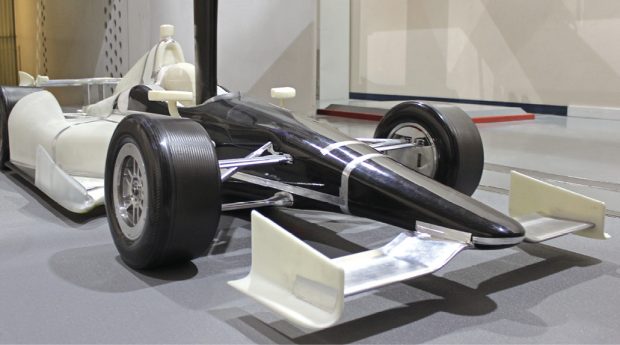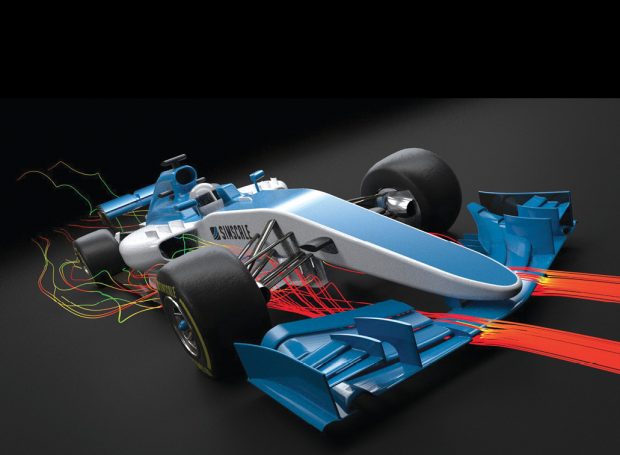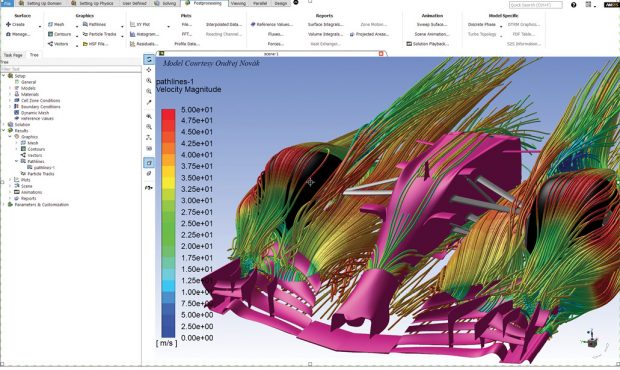
As part of its workflow, ARC taps full-scale wind tunnel testing for final validation of parts from CFD and scale model testing. Image courtesy of Auto Research Center.
Latest News
July 1, 2018
Historically, the lion’s share of aerodynamics work has been channeled toward aesthetics, trying to nail down the optimized organic shape or determine the impact of an accessory on final design performance. In the wake of more stringent fuel regulations, automakers are taking a broader approach, shifting beyond pure styling concerns to consider all aspects of vehicle design as it relates to the impact on airflow and drag. As part of this holistic strategy, companies are remodeling workflows and expanding use of computational fluid dynamics (CFD) software to tackle multidisciplinary aerodynamic challenges far earlier in the design process.

SimScale leverages the cloud to democratize CFD analysis, as with this example of an F1 race car. Image courtesy of SimScale.
“Aerodynamics has typically been considered through the lens of how it impacts certain parts of the design such as upper body style—what’s changed is that that’s no longer enough to reach the targeted coefficients,” says Bradley Duncan, senior director of aerodynamics applications at Exa Corp., a wholly owned subsidiary of Dassault Systèmes. “Today, every inch of the car has to be designed with aerodynamics in mind and you have to be ready to make trade-offs to achieve that performance.”
Given that aerodynamics is now a full-vehicle pursuit, it’s next to impossible to nail down specifics, identify potential problem areas and optimize structures using only physical studies in wind tunnels or on-road testing, experts say. For one thing, that approach requires engineering teams to have a physical model of the vehicle, which means the majority of key design decisions are already well-established, making it both difficult and expensive to make changes. At the same time, time-to-market pressures are collapsing the vehicle development cycle, requiring automakers to put new tools and workflows in place to streamline the design process.
“There’s more pressure to optimize things quicker and get answers faster,” notes Andy Wade, lead application engineer at ANSYS. “The problems are the same as they were before—we just need answers faster.”
CFD Dominates Early-Stage Design
By leveraging CFD earlier, engineering teams can spend less time building multiple physical prototypes and more time creating high-fidelity virtual models that can be run through their paces and easily modified in the digital world. “As fast as you can engineer some new CAD design on your computer, you can turn around a simulation result,” Wade explains.

Advances in computational horsepower, coupled with sophisticated analysis capabilities, allow for CFD results on higher fidelity models. Image courtesy of ANSYS.
Moreover, with more accessible, increased computing capacity on the desktop or in the cloud, engineering teams can create higher fidelity car models, which means CFD can produce more accurate results. “Before when you compared CFD and wind tunnel tests, people couldn’t afford to model all the details of a car—they had to simplify things,” Wade explains. “Now you can throw all the features in there and get a realistic car model.”
CFD aerodynamics studies are particularly useful for teams starting from scratch with new car programs or making radical changes to existing models, as they provide a higher level of design freedom to explore different ideas and less conservative concepts. Determining how the addition of bold character lines or significant changes in topology would impact airflow in the conceptual stage is where CFD can shine, experts say. Further into the development cycle, CFD simulation also plays a role in perfecting designs and solving complex engineering problems—for example, determining whether there is enough cooling air emanating through a modified grill or when there is a need to consider coupled physics problems.
“When you have different physics problems that need to be solved simultaneously, it’s easier to do digitally,” notes Dr. Paul Stewart, vice president, automotive aerodynamics modeling and visualization for Altair, provider of the HyperWorks’ AcuSolve CFD solver and ultraFluidX, a simulation tool optimized for GPU technology. Consider the example of a brake cooling system. Although it’s a thermal problem, Stewart says it also involves design issues related to how to get air through the car body to cool the brake discs under all conditions. It’s a similar dynamic trying to study the impact of side mirrors, which couple aerodynamics with acoustic design studies.
“When you are trying to solve two problems simultaneously, setting up a physical test where you have enough information or detailed information can be challenging,” Stewart explains. “There, CFD makes the most sense.”
Optimization is also an area where virtual CFD studies have an advantage over physical prototypes in the wind tunnel. Say a design team is trying to determine the optimal angle of a spoiler on a deck lid by making small, iterative tweaks that shift things by a couple of degrees—if that’s the only feature being explored, then it can be efficient to do with clay models in a wind tunnel.
However, if that study also considers other features on the car—the hood angle or the step size of the side glass panel recess in addition to the spoiler angle—then it’s far more difficult to get optimal results using physical testing methods and much more efficient to automate via use of CFD software. “So many different surfaces on a car can change slightly and have a big impact on performance,” he says. “CFD allows you to explore dozens of combinations and find the optimized result whereas in a wind tunnel, you’d need to continuously reshape clay to make design changes.”

As part of its workflow, ARC taps full-scale wind tunnel testing for final validation of parts from CFD and scale model testing. Image courtesy of Auto Research Center.
The advent of cloud-based simulation platforms like SimScale have helped democratize simulation and promote its use earlier in the process. Instead of requiring automakers to invest in high performance computing platforms and expensive CFD subscriptions, SimScale’s cloud-based CFD and finite element analysis tools become as accessible as CAD software, helping users embrace CFD in early-stage design and solve multiple problems in parallel as opposed to waiting days, if not weeks, for access to high-end systems.
Although cloud-based CFD factors more prominently in early-stage design and throughout the overall process, it is not a flat-out replacement for wind tunnels or other forms of physical testing, notes David Heiny, CEO and co-founder of SimScale. “CFD never replaces a wind tunnel, it just replaces some wind tunnel testing,” he explains. “Both have advantages and disadvantages, and companies benefit best by having access to both.”
Two-Pronged Approach
Experts advocating use of both methods don’t have hard-and-fast rules, other than it depends on the specific use case and engineering problem as well as access to available tools and resources.
The Automotive Research Center (ARC), which provides aerodynamics consulting services for transportation companies, including the automotive supply chain, got its start as the North American headquarters for Reynard Motorsport race car design and, in the beginning, primarily used wind tunnel tests. The company, which has branched out with CFD and scale and full-model testing services, leans on CFD in early vehicle design for understanding downforce, drag and fluid flow structure while turning to scale model wind tunnel testing to run through large numbers of parts and for certification and validation, according to Andrew Mosedale, the company’s head of aerodynamics.
“The advantage of starting with CFD testing is you can test radically different concepts at a relatively low cost without actually making parts and understand flow,” he says. Once there are a smaller number of questions to answer or much of a design is fixed, then it’s time to move on to physical wind tunnel testing, he says.
CFD and wind tunnel tests also deliver different kinds of information, which can help determine when to use the different approaches. CFD is optimal for producing full-field data such as the ability to look closely at where flow is going or how external temperatures might impact brake cooling—all data points that aren’t provided by a wind tunnel, ANSYS’ Wade explains.
On the other hand, CFD requires engineers to make certain assumptions about the model, from materials used to details about the car, which could impact result accuracy. “There’s a small line between the real world and extreme detail that you need to take into account, so that’s why it’s good to finally put the model in the wind tunnel to see what a real-world, physical object does,” Wade says.
Wind tunnel tests are well-suited for verification and certification purposes and to rapidly test a series of minor changes quickly—for example, testing different wheel designs. “If you’re evaluating 10 to 20 wheel designs, you’d do better in a wind tunnel because a full CFD simulation could take overnight [to run],” says Altair’s Stewart. “From a computational cost point of view, there are some sweet spots where the wind tunnel is preferable.”
For some, the best results are achieved with a mix of three methods—CFD, wind tunnel exercises, and on-track testing. The Red Bull Racing team employs all three modes in its aerodynamics workflows, leveraging CFD and 60% scale wind tunnel testing to get a detailed picture of the impact of flow on cars and then turning to on-track testing for verification, according to Craig Skinner, the team’s deputy head of aerodynamics. CFD is used throughout the design process because it visualizes the entire flow around the car and enables detailed analysis. On the flip side, it only depicts one particular car condition—a straight line or cornering, for example—so multiple runs are necessary for a robust assessment. The wind tunnel’s strength is that it allows the Red Bull team to collect a large amount of data within a short period of time while providing a greater understanding of how the car performs, Skinner explains. The FIA organization, which imposes strict limits on usage of CFD and wind tunnel resources for the Formula One race league, also has bearing on the optimal aerodynamics workflow.
“Typically, a new idea or concept will be assessed in CFD first and if it looks interesting, it will be sent to the wind tunnel for further evaluation,” Skinner says. “We are constantly monitoring and balancing our usage of the tools to meet our development needs and to deliver the maximum amount of performance to track.”
For More Info
Subscribe to our FREE magazine, FREE email newsletters or both!
Latest News
About the Author
Beth Stackpole is a contributing editor to Digital Engineering. Send e-mail about this article to [email protected].
Follow DE





